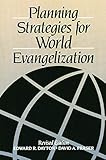Planning strategies for world evangelization /by Edward R. Dayton and David A. Fraser.
Material type: TextPublication details: Grand Rapids, Michigan : W.B. Eerdmans ; 1990.; Monrovia, California : MARC, (c)1990.Edition: Revisedition. editionDescription: xv, 349 pages ; (c)23 cmContent type:
TextPublication details: Grand Rapids, Michigan : W.B. Eerdmans ; 1990.; Monrovia, California : MARC, (c)1990.Edition: Revisedition. editionDescription: xv, 349 pages ; (c)23 cmContent type: - text
- unmediated
- volume
- 9780802804228
- BV2061 .P536 1990
- COPYRIGHT NOT covered - Click this link to request copyright permission: https://lib.ciu.edu/copyright-request-form
| Item type | Current library | Collection | Call number | Status | Date due | Barcode | |
|---|---|---|---|---|---|---|---|
 Circulating Book (checkout times vary with patron status)
Circulating Book (checkout times vary with patron status)
|
G. Allen Fleece Library CIRCULATING COLLECTION | BV2061.D276.P536 1990 (Browse shelf(Opens below)) | Available | 31923001735899 | |||
| Withdrawn | G. Allen Fleece Library WITHDRAWN | Non-fiction | BV2061.D35 1990 (Browse shelf(Opens below)) | 1 Not for loan | 31923000764338 | ||
 Circulating Book (checkout times vary with patron status)
Circulating Book (checkout times vary with patron status)
|
G. Allen Fleece Library CIRCULATING COLLECTION | Non-fiction | BV2061.D35 1990 (Browse shelf(Opens below)) | Available | 31923000764346 |
Browsing G. Allen Fleece Library shelves, Shelving location: WITHDRAWN, Collection: Non-fiction Close shelf browser (Hides shelf browser)
CIU ALUMNI AUTHOR
Includes bibliographies and index.
Beginnings What Do We Mean by a People or People Group? A Comprehensive Approach Is Needed Perspective The Future Lies in the Future A Theology of the Future The Importance of the Future Strategy Why Have a Strategy? Types of Strategies Is Our Strategy "Western"? What Happens When We Have No Strategy? Management What Do We Mean by Management? Nehemiah Was a Manager The Role of the Holy Spirit Recapturing the Biblical Balance Management for Mission An Overview of the Task The Basic Approach A Circular Model Defining the Mission Considerations Mission and Evangelization Mission and the Church Evangelization The Meaning of Evangelism Defining Evangelism When Developing a Strategy Evangelization as a Process Defining Your Mission Assumptions for Mission Definition The Need for Mission Definition Field Selection Practices Theology and Field Selection Field Selection Criteria Unreached People Defined Perspective The People to be Reached Considerations A People-Centered Approach The Importance of a People-Centered Approach Peoples and People Groups in the Bible Evangelism and Peoples of the New Testament World Paul's People-Centered Approach Defining and Describing Peoples and People Groups The Debate about Mono-Ethnic Churches The Homogeneous Unit and People Group Evangelization Membership in Groups What Are Peoples and People Groups? Understanding Peoples and People Groups Three-Dimensional Understanding The Meaning System of Peoples and People Groups Understanding the Needs of Peoples and People Groups Understanding the Behavior of Peoples and People Groups Receptivity and Resistance The Force for Evangelization Considerations The People Available What Is This People Group Like? Looking for the Best Fit The Going Community Recruiting Thousands of Young People Are Willing to Be Trained The Challenge of Training The Local Church Can Change the World The Organizations Available Organizational Structures Priorities for the Christian Organization An Organizational Checklist Missions in Partnership Means and Methods Considerations Selecting Means and Methods Methods and the Holy Spirit What Difference Do Methods Make? What Are Means and Methods? Classifying Methods Selecting Methods for Evangelization Perspective on the Selection Process Developing Means and Methods New Testament Examples The Experiences of Other Christians The Experience of Pseudo-Christian and Other Religious Movements The Means and Methods of the People Group Being Evangelized Development as Evangelism Final Considerations Defining an Approach Considerations Planning the Strategy Levels of Strategy The Example of the Turkana The Diffusion of Innovation Stating Our Approach Assumptions Assumptions about Yourself Assumptions about the Organization Assumptions about Other Churches and Missions Assumptions about the Country in Which You Work Assumptions about the World What Now? Anticipated Outcomes Considerations Movement Toward Christ The Meaning of Conversion The Starting Point The Ultimate Objective The Resulting Church The Church in the Freedom of the Spirit Models for the Resulting Church Criteria for the Resulting Church Ready for Results Four Types of Possible Outcomes Ways We Hide from Results Changes and the Strategy Cycle Failing on Paper Your Role Considerations Who Are You? Roles and Social Structures Personal Role Definition Our Primary Role Identification Where Do You Fit? Questions to Ask Bringing About Change Planning Considerations Goals for Evangelization The Difference between Purposes and Goals The Relationship of Goals to One Another The Power and Advantages of Goals Writing Clear Goals and Purposes Goals for People Plans for Evangelization What Do We Mean by Planning? Thinking Christianly about Planning Basic Planning Concepts The Dynamics of Planning Short-and Long-Range Planning Methods for Planning Act Considerations Taking Action Resources, Means, Goals Course Correction--Replanning Evaluation Considerations Evaluation Set up an Evaluation Procedure Goals Evaluation Evaluating Means and Methods Evaluating Resources Evaluation as a Process Personal Performance Evaluation Closing the Circle
COPYRIGHT NOT covered - Click this link to request copyright permission:
There are no comments on this title.

